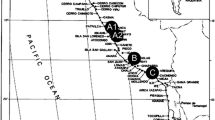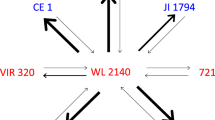Summary
Hybrids were obtained from Ipomoea interspecific crosses through ovule culture. The hybridity of the progeny obtained from I. triloba × IitI. trifida and (I. triloba × I. lacunosa) × I. batatas (4x) crosses was established by comparisons of floral morphology and analyses of peroxidase and esterase isozymes. The hybrids displayed the inflorescence type and sepal shape and texture of their male parents, while corolla size and anther and nectary color tended to be intermediate to their parents. The isozyme banding patterns of the hybrids contained bands present in the patterns of each of their parents. Pollen grain viability, measured by aceto-carmine stainability, was 44.1%, 92.3% and 82.4%, respectively, for the I. triloba × I. trifida hybrid and the (I. triloba × I. lacunosa) × I. batatas (4x) hybrids, H1 and H2. A controlled pollination study revealed that the I. triloba × I. trifida, and the (I. triloba × I. lacunosa) × I. batatas (4x) hybrids, H1 and H2 were partially self fertile with 6%, 70% and 13%, respectively, of the pollinated flowers producing viable seed. Success in backcrossing and sib-mating varied with the cross combination.
Similar content being viewed by others
References
Austin, D.F., 1988. The taxonomy, evolution & genetic diversity of sweet potatoes & related species. pp. 27–59. In: P. Gregory (Ed). Exploration, Maintenance and Utilization of Sweet Potato Genetic Resources: Report of the 1 st sweet potato planning conference 1987. CIP, Lima, Peru.
International Potato Center, 1990. Annual Report CIP 1990. Lima, Peru. 258 p.
Hozyo, Y. & S. Kato, 1973. The plant production of wild type plants in Ipomoea trifida (H.B.K.) Don. Tokyo Natl. Inst. Agr. Sci. Bull. Ser. D. 24: 35–60.
Iwanaga, M., 1988. Use of wild germplasm for sweet potato breeding. pp. 199–210. In: P. Gregory (Ed). Exploration, Maintenance and Utilization of Sweet Potato Genetic Resources: Report of the 1st sweet potato planning conference 1987. CIP, Lima, Peru.
Iwanaga, M., R. Freyre & G. Orjeda, 1991. Use of Ipomoea trifida (H.B.K.) G. Don germplasm for sweetpotato improvement. Genome 34: 201–208.
Jarret, R.L., N. Gawel & A. Whittemore, 1992. Phylogenetic relationships of the sweetpotato (Ipomoea batatas (L.) Lam.). J. Amer. Soc. Hort. Sci. 117: 633–637.
Jones, A. & M.T. Deonier, 1965. Interspecific crosses among Ipomoea lacunosa, I. ramoni, I, trichocarpa and I. triloba. Bot. Gaz. 126: 226–232.
Jones, A. & M. Kobayashi, 1968. Derived polyploids of section Batatas genus Ipomoea. Proc. Amer. Soc. Hort. Sci. 93: 497–501.
Kobayashi, M., 1984. The Ipomoea trifida complex closely related to sweet potato. Proc. 6th Symp. Int. Soc. Trop. Root Crops, 1983. pp. 561–568. CIP, Lima, Peru.
Kobayashi, R.S., J.L. Brewbaker & H. Kamemoto, 1987. Identification of Anthurium andraeanum cultivars by gel electrophoresis. J. Amer. Soc. Hort. Sci. 112: 164–167.
Kobayashi, R.S., S.L. Sinden & J.C. Bouwkamp, 1993. Ovule culture of sweet potato (Ipomoea batatas) and closely related species. Plant Cell Tissue Organ Cult. 32: 77–82.
Martin, F.W., 1970. Self- and interspecific incompatibility in the Convolvulaceae. Bot. Gaz. 131: 139–144.
Martin, F.W., 1982. Analysis of the incompatibility and sterility of sweet potato. p. 275–283. In: R.L. Villareal & T.D. Griggs (Eds). Sweet Potato: Proc. 1st Int. Symp. AVRDC, Tainan, Taiwan.
Martin, F.W. & A. Jones, 1973. The species of Ipomoea closely related to the sweet potato. Econ. Bot. 26: 201–215.
Nishiyama, I., 1982. Autohexaploid evolution of the sweet potato. p. 263–274. In: R.L. Villareal & T.D. Griggs (Eds). Sweet Potato: Proc. 1st Int. Symp. AVRDC, Tainan, Taiwan.
Nishiyama, I., T. Miayzaki & S. Sakamoto, 1975. Evolutionary autoploidy in the sweet potato Ipomoea batatas (L.) Lam.) and its progenitors. Euphytica 24: 197–208.
Shiotani, I., S. Yoshida & T. Kawase, 1990. Numerical taxonomic analysis and crossability of diploid Ipomoea species related to the sweet potato. Jap. J. Breed. 40: 159–174.
Teramura, T., 1979. Phylogenetic study of Ipomoea species in the section Batatas. Mem. Coll. Agr. Kyoto Univ. 114: 29–48.
Wedderburn, M.M., 1967. A study of hybridisation involving the sweet potato and related species. Euphytica 16: 69–75.
Author information
Authors and Affiliations
Rights and permissions
About this article
Cite this article
Kobayashi, R.S., Bouwkamp, J.C. & Sinden, S.L. Interspecific hybrids from cross incompatible relatives of sweetpotato. Euphytica 80, 159–164 (1994). https://doi.org/10.1007/BF00039646
Received:
Accepted:
Issue Date:
DOI: https://doi.org/10.1007/BF00039646




